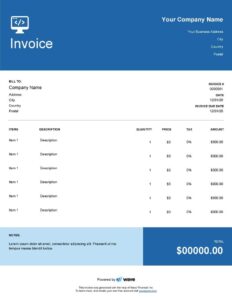Let’s talk about invoicing. Money is a sensitive topic, and most people try as much as possible to avoid it. But from my experience, I can tell you that it is very important. You just need to understand and know when, how and why to talk about it, most especially with you clients. Today I shall like to touch on the topic of invoicing and what I believe is a good way to go about it.

Before we start sending out invoices, we should at least know what they are, right? We have all received an invoice for something we ordered or a service. Basically, an invoice is a document given to a client or customer in this case by the service provider to collect payment for services rendered. They demonstrate a client’s obligation to pay you for your services.
As a freelancer, some invoices you would need to have ready to issue out include:
- Web Design & Development Invoicing
- Web Hosting Invoicing
- Web Content, Copy & SEO Invoicing
- Web Security Invoicing
- Maintenance Invoicing
Some of these may be one time issuance while some might be recurring depending on the frequency, agreement and business policy. For instance, a development invoice is one time for a contract while a maintenance invoice is a recurring invoice. A maintenance invoice might be monthly, quarterly, bi-annually or annually, depending on the business policy.
While it takes hard work, collaboration and dedication to do what you do, your invoice needs to make that clear and outline to the clients, so they understand what they are being charged for. That means that your invoice needs to be simple enough and at the same time accurately capture what is being put into the project.
From my experience, it can be quite difficult sometimes to send out invoices and get paid on time. But a business thrives on cash flow. For you to get a positive cash flow, you will need to do a few things to get paid on time and much more efficiently.
Professional Invoicing
You need to get serious about financial organization. At this point you should be aware there are tons of invoicing platforms and solutions out there. If you don’t you should start doing some research on that, I won’t be recommending any just yet! But you also need to be careful with these systems you choose. I personally have mine self-hosted and readily accessible when I need it. These solutions have great benefits and will take care of your business for you.

Your invoice to clients should have the following:
- Company Details: Your current and updated business information including name, phone numbers, address, emails and logo where applicable.
- Customer Details: The customer’s name, business/company name, address and contact information.
- Invoice Number: A unique invoice number to help track down the invoice in the future.
- Dates: Include the date of issue and date when payment is due.
- Line Items: details of the service or solution for which the client is being invoiced. The information includes the item name and description, quantity, unit price, TAX and amount.
- Total: A total price would be the summation of all line-item amount. Outline the total amount due after tax.
- Notes: Any additional information which your customer should know regarding the invoice policy and terms. Example: “Payments are due net 7 days after the invoice has been issued”
Terms & Conditions
By now we have all heard “Set boundaries, respect them and people will too!”. Well in business, freelancing the equivalent are your Terms & Conditions. These are very important, and they set a tone for your business and working process. These have to be clear and concise with no ambiguity as much as possible.
Your terms and conditions should be able to foresee a major part of your work and try to cover everything. However, it should also allow for room for negotiations and growth. Terms and Conditions with respect to invoicing includes due dates, late payments & fee policies, payment methods and how you will be paid on a project. Examples of the above are:
- Due Dates: “Payments are due within 7-14 days on issue.”
- Late Payments: “Late payment attract X amount for everyday payment is not received.”
- Payment Method: “Payment are to be made via Mobile Money or Bank Deposits to the following accounts…”
- Project Payment Terms: “Client must pay 70% on the start of the project and 100% of the remainder on project completion without delay.”
Take Action
We all want to be paid more quickly and for that to happen we need to be more proactive by sending out invoices on time. Even if they are a friend or someone you know, do not assume they are aware. NO! What I do once I have the contract approved is I move to generate the invoice for the project and send that to the client. I don’t expect payment immediately, depending on the agreement and payment terms but this will be more appreciated in the second action. Before sending out the invoice, make sure all information are updated and correct! Define all project tasks as clearly as possible.
The second action to take is to follow up! Assuming you already issued the client with an invoice at the start of the project. On completion, you are spent and need a break which sometimes translate to not being able to effectively send out your invoice on time. Well, now that was solved earlier and all you need to do now is prompt and remind them of the pending fulfillment!
The reason you need to take an action of following up is because some clients simply: well, they forget! Your reminders need to be gentle and polite. Do not assume they are refusing to pay. That is a topic for some other time! This is enough to receive firm feedback!
If that does not work, the second time you should make a polite call to your client and inquire about payment. Although in the modern age telephoning has fallen out of favor, it is a faster way to get your answer.
Concluding Tips
- Make sure your invoice has all the relevant information updated and correct; due dates, contact information.
- Have clear and concise invoicing terms and conditions, make use of multiple payment options; take advantage of the most common and available.
- Invoice on time and be sure to follow up!
Chasing your payments can be a daunting task, but by implementing these steps and tips will make the process more efficient and improve your cash follow positively.





